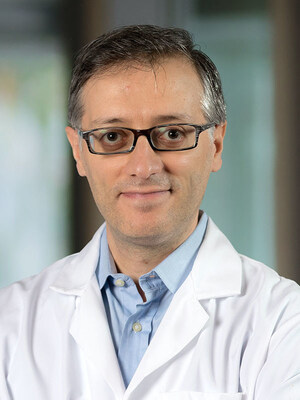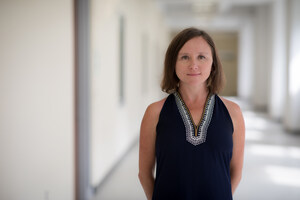BRONX, N.Y., May 29, 2014 /PRNewswire-USNewswire/ -- Research by scientists at Albert Einstein College of Medicine of Yeshiva University may help explain how some cases of autism spectrum disorder (ASD) can result from environmental influences rather than gene mutations. The findings, published online today in PLOS Genetics, shed light on why older mothers are at increased risk for having children with ASD and could pave the way for more research into the role of environment on ASD.
The U.S. Centers for Disease Control and Prevention announced in March that one in 68 U.S. children has an ASD—a 30 percent rise from 1 in 88 two years ago. A significant number of people with an ASD have gene mutations that are responsible for their condition. But a number of studies—particularly those involving identical twins, in which one twin has ASD and the other does not—show that not all ASD cases arise from mutations.
In fact, a major study of more than 14,000 children with ASDs published earlier this month in the Journal of the American Medical Association concluded that gene abnormalities could explain only half the risk for developing ASD. The other half of the risk was attributable to "nongenetic influences," meaning environmental factors that could include the conditions in the womb or a pregnant woman's stress level or diet.
Media reports on the causes of ASD have focused on the fact that older fathers (40 and over) are more likely than younger fathers to have children with an ASD, probably because of gene mutations that accumulate over the years in sperm-making cells. Yet older mothers (35 and over) face a similar risk that is entirely independent of their partners' age. But for older mothers, scientists know very little about why this risk exists. The Einstein researchers looked for genetic as well as environmental influences that might account for older mothers' increased risk for having children with ASD.
Their study, led by Esther Berko, an M.D./Ph.D. student in the lab of John Greally, M.B., B.Ch., Ph.D., involved 47 children with ASD and 48 typically developing (TD) children of women 35 and over. Unlike other ASD studies, this one included a significant number of minority children (Hispanic and African-American) from the Bronx. Brain cells––the obvious cells to examine for evidence of genetic and environmental differences between ASD and TD children—obviously could not be used. Instead, the researchers realized that if such differences existed, they should also occur in a readily available type of cell: the buccal epithelial cells that line the cheek.
"We hypothesized that whatever influences lead to ASD in children of older women probably are already present in the reproductive cells that produce the embryo or during the very earliest stages of embryonic development—in cells that give rise to both the buccal epithelium and the brain," said Dr. Greally, the study's senior author. "This would mean that whatever abnormalities we found in the cheek cells of children with an ASD versus TD children should exist in their brain cells as well." Dr. Greally is professor of genetics, of medicine and of pediatrics, director of the Center for Epigenomics and the Ruth L. and David S. Gottesman Faculty Scholar for Epigenomics at Einstein and attending physician, pediatrics at The Children's Hospital at Montefiore.
Small brushes were used to painlessly harvest cheek cells from children with an ASD and TD children living in the Bronx and throughout the U.S., as well as in Chile and Israel. Since the eggs of older mothers are prone to having abnormal numbers of chromosomes, the researchers first analyzed the cells for abnormal chromosome numbers as well as other chromosomal defects that might account for ASD. No such problems were found in the cells of ASD or TD children.
The researchers next examined the children's cells for evidence of environmental effects.
"If environmental influences were exerted during embryonic development, they would encode a "memory" in cells that we can detect as chemical alterations of genes," said Dr. Greally. "Most of these so-called epigenetic alterations are in the form of methyl groups that chemically bind to DNA. Such methyl groups are vital for controlling gene activity, but changes in methylation patterns can dysregulate cell function by altering gene expression or by silencing genes entirely."
Dr. Greally and his colleagues carried out several types of genome-wide methylation analyses on the cheek cells of the ASD and TD children, looking for epigenomic differences that would suggest environmental influences at work. (Just as "genome" is defined as the genetic material of an organism, "epigenome" includes the patterns of methyl groups that have attached to an organism's entire genome.)
This was the largest epigenome-wide association study of ASD to date involving a single pure cell type. Using just one cell type—epithelial cheek cells in this case—helps prevent misleading results that can occur when epigenomic studies combine several different subpopulations of cells. "We were extremely careful in how we conducted this study, to ensure that whatever we found was as scientifically valid as possible," said Dr. Greally.
The researchers detected two groups of genes that were epigenetically distinctive in children with ASD compared with TD children. Moreover, these genes are known to be expressed in the brain and code for proteins involved in nerve transmission functions previously shown to be impaired in ASD. (Interestingly, these two groups of epigenetically distinctive genes weren't present in all the cells of children with ASD but only in a subset of them—a phenomenon called mosaicism.) In addition, these two gene groups tended to interact with genes already known to be mutated in individuals with ASD.
"Genes interact with each other to create molecular pathways that carry out important functions," said Dr. Greally. "Our findings suggest that, at least in some individuals with an ASD, the same pathways in the brain seem to hit by both mutations and epigenetic changes. So the severity of someone's ASD may depend on whether or not a gene mutation is accompanied by epigenetic alterations to related genes."
Are environmental influences responsible for the epigenetic changes that dysregulate these genes? "We were able to eliminate some other possible causes of ASD such as chromosomal abnormalities, so our findings are consistent with that notion," said Dr. Greally. "In the case of older mothers at risk for having children with ASDs, one possible environmental influence might the aging process itself, which could disturb epigenetic patterns in their eggs, but there are other possibilities as well. Although much more work is needed, our study reveals a plausible way that environmental influences—which we know are important in ASD—might be exerting their effects."
The study is titled "Mosaic epigenetic dysregulation of ectodermal cells in autism spectrum disorder." Other Einstein authors of the study were lead author Esther Berko; Masako Suzuki, D.V.M., Ph.D.; Christophe Lemetre; Christine Alaimo; R. Brent Calder; Jill Kirschen, R.N., B.S.N.; Shahina B. Maqbool, Ph.D.; Zeineen Momin; David Reynolds; Karen Ballaban-Gil, M.D.; Natalie Russo, Ph.D.; Maria Valicenti-McDermott, M.D.; Lisa Shulman, M.D.; Edyta Stasiek, Dov Inbar, M.D.; Jessica Tozour, Brett Abrahams, Ph.D.; Joseph Hargitai, Zhengdong Zhang, Ph.D.; Sophie Molholm, Ph.D.; John Foxe, Ph.D.; Robert Marion, M.D.; and Adam Auton, Ph.D. Additional authors were Faygel Beren, Kaylee Kampf and Batya Gounder, Stern College for Women, Yeshiva University (New York, NY); Shenglong Wang, New York University (New York, NY); and Joseph D. Buxbaum, Ph.D., Icahn School of Medicine at Mount Sinai (New York, NY). Funding supporting the project was provided by the Jonas Ehrlich Charitable Foundation and by Autism Speaks. The authors also thank Autism Speaks for its help in recruiting participants for this study.
About Albert Einstein College of Medicine
Albert Einstein College of Medicine of Yeshiva University is one of the nation's premier centers for research, medical education and clinical investigation. During the 2013-2014 academic year, Einstein is home to 734 M.D. students, 236 Ph.D. students, 106 students in the combined M.D./Ph.D. program, and 353 postdoctoral research fellows. The College of Medicine has more than 2,000 full-time faculty members located on the main campus and at its clinical affiliates. In 2013, Einstein received more than $155 million in awards from the NIH. This includes the funding of major research centers at Einstein in diabetes, cancer, liver disease, and AIDS. Other areas where the College of Medicine is concentrating its efforts include developmental brain research, neuroscience, cardiac disease, and initiatives to reduce and eliminate ethnic and racial health disparities. Its partnership with Montefiore Medical Center, the University Hospital and academic medical center for Einstein, advances clinical and translational research to accelerate the pace at which new discoveries become the treatments and therapies that benefit patients. Through its extensive affiliation network involving Montefiore, Jacobi Medical Center –Einstein's founding hospital, and five other hospital systems in the Bronx, Manhattan, Long Island and Brooklyn, Einstein runs one of the largest residency and fellowship training programs in the medical and dental professions in the United States. For more information, please visit www.einstein.yu.edu, read our blog, follow us on Twitter, like us on Facebook, and view us on YouTube.
Logo - http://photos.prnewswire.com/prnh/20120531/DC16559LOGO
SOURCE Albert Einstein College of Medicine
WANT YOUR COMPANY'S NEWS FEATURED ON PRNEWSWIRE.COM?
Newsrooms &
Influencers
Digital Media
Outlets
Journalists
Opted In






Share this article